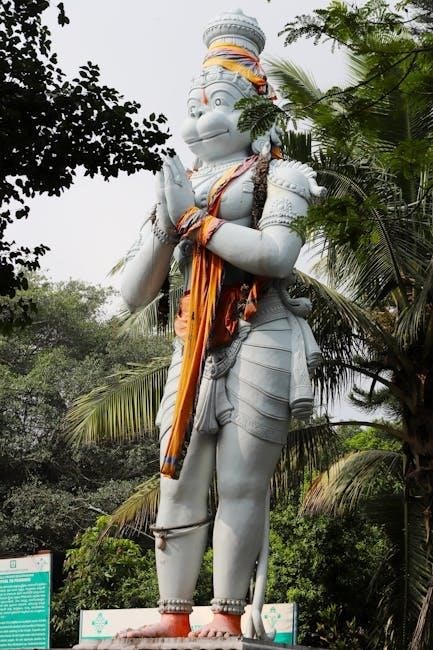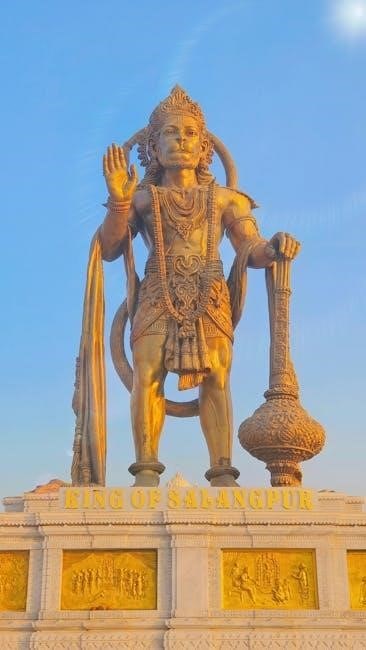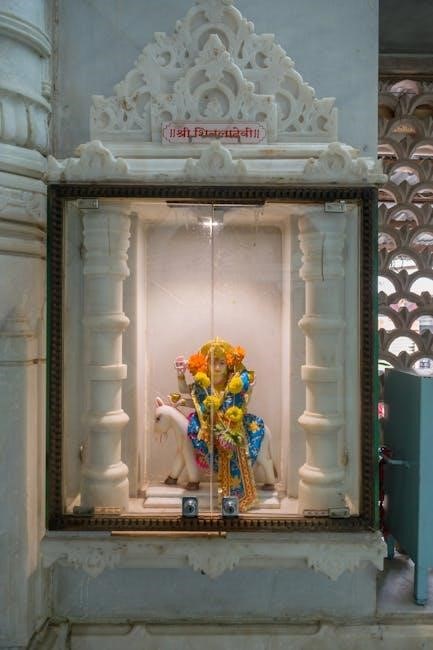Laxmi Chalisa is a devotional hymn dedicated to Goddess Lakshmi, consisting of 40 verses that praise her divine grace and prosperity․ It is a popular prayer recited during puja ceremonies, especially on Fridays and Sharad Purnima, to seek her blessings for wealth and happiness․ The hymn is often chanted alongside other sacred texts like Vishnu Sahasranama, emphasizing its spiritual significance in Hindu devotion․ Its melodious renditions and availability in PDF formats make it accessible for devotees worldwide to worship and connect with Goddess Lakshmi․
Significance of Laxmi Chalisa in Hindu Devotion
Laxmi Chalisa holds profound significance in Hindu devotion as a powerful prayer to invoke Goddess Lakshmi’s blessings for prosperity, wealth, and happiness․ Comprising 40 verses, it is recited during pujas, especially on Fridays and Sharad Purnima, to seek divine grace․ Devotees believe that chanting the Chalisa brings good fortune, health, and spiritual growth․ Its melodious renditions and availability in PDF formats have made it accessible for worship worldwide․ The hymn is often chanted alongside Vishnu Sahasranama, reflecting its deep connection to Hindu spirituality and the desire to connect with the divine feminine energy of Goddess Lakshmi․
Structure and Composition of Laxmi Chalisa
Laxmi Chalisa is a 40-verse devotional hymn dedicated to Goddess Lakshmi, structured to honor her divine attributes․ Each verse praises her power to bestow wealth, prosperity, and happiness․ The hymn is often recited during pujas and is available in PDF formats for easy access․ Its composition reflects deep spiritual connection, making it a cherished prayer among devotees seeking her blessings․

Importance of Goddess Lakshmi
Goddess Lakshmi embodies wealth, prosperity, and divine beauty, revered as the consort of Lord Vishnu․ Her blessings are sought for a harmonious and affluent life, symbolizing purity and good fortune․
Goddess Lakshmi as the Embodiment of Wealth and Prosperity
Goddess Lakshmi is revered as the divine embodiment of wealth, prosperity, and good fortune․ She is often depicted with four arms, holding a lotus and showering gold coins, symbolizing her generosity․ As the consort of Lord Vishnu, she represents balance and harmony in life․ Devotees worship her to attain material abundance, spiritual growth, and familial bliss․ Her blessings are believed to ward off adversity and bring positivity․ The Laxmi Chalisa, a devotional hymn, is a popular medium to connect with her divine energy and seek her grace for a prosperous life․
The Role of Goddess Lakshmi in Hindu Scriptures
Goddess Lakshmi holds a prominent place in Hindu scriptures, particularly the Puranas and Vedas, where she is celebrated as the consort of Lord Vishnu․ She is depicted as the embodiment of wealth, beauty, and divine grace․ In the Vishnu Sahasranama, she is praised as the source of all prosperity․ Lakshmi’s marriage to Vishnu symbolizes the union of power and wisdom․ Her avatars, such as Sita and Rukmini, highlight her role in maintaining dharma and cosmic balance․ Scriptures often describe her as the remover of obstacles, ensuring well-being and fortune for devotees who seek her blessings through hymns like the Laxmi Chalisa․

The Rituals and Benefits
Reciting Laxmi Chalisa on Fridays and during puja attracts positive energy, ensuring prosperity and well-being․ Devotees believe it brings wealth, health, and divine blessings․
Best Time to Recite Laxmi Chalisa
The ideal time to recite Laxmi Chalisa is during early mornings or evenings, especially on Fridays, considered auspicious for worshiping Goddess Lakshmi․ Sharad Purnima, a full moon night in autumn, is also highly significant, as it is believed that the moon showers divine blessings․ Reciting the Chalisa during these times is said to enhance its spiritual impact, attracting wealth, prosperity, and positive energy․ Devotees often chant it 11 or 21 times for amplified benefits, ensuring a peaceful and prosperous life under Goddess Lakshmi’s grace․
Benefits of Reciting Laxmi Chalisa
Reciting Laxmi Chalisa is believed to bring prosperity, wealth, and happiness into one’s life․ It helps devotees overcome financial difficulties and attracts positive energy․ The hymn is also known to foster emotional balance and gratitude․ Regular recitation is thought to remove obstacles, ensuring smooth progress in personal and professional life․ Additionally, it strengthens one’s faith and connection with Goddess Lakshmi, who is revered as the embodiment of wealth and fortune․ By chanting the Chalisa, devotees seek her blessings for a peaceful and prosperous life, free from negativity and adversity․

How to Perform the Puja
Begin by cleaning the worship area, lighting a lamp, and offering flowers to Goddess Lakshmi․ Recite the Laxmi Chalisa with concentration, followed by aarti․ Seek forgiveness for any mistakes during the ritual, ensuring a pure and devoted puja experience․
Preparation and Rituals for Laxmi Puja
Prepare the worship area by cleansing and arranging necessary items like flowers, incense, and a lamp․ Place Goddess Lakshmi’s idol or image respectfully․ Light the lamp, offer flowers, and recite the Laxmi Chalisa with devotion․ Traditional offerings include kheer, sweets, and coins, symbolizing prosperity․ During Sharad Purnima, kheer is left under the moonlight overnight․ Conclude the puja with aarti, seeking forgiveness for any mistakes and expressing gratitude for her blessings․ This ritual ensures a pure and heartfelt connection with Goddess Lakshmi․
The Role of Aarti in Laxmi Puja
Aarti is a sacred devotional song sung during Laxmi Puja to express devotion and gratitude․ It is performed after reciting the Laxmi Chalisa, marking the culmination of the worship ritual․ The aarti involves waving a lamp, incense, and offerings like sweets before Goddess Lakshmi’s idol․ This practice symbolizes the devotee’s surrender and reverence, seeking her blessings for prosperity and peace․ The melodious aarti creates a spiritually charged atmosphere, deepening the connection between the devotee and the divine․ It is an integral part of the puja, embodying the essence of Hindu worship and devotion․

Sharad Purnima and Laxmi Chalisa
Sharad Purnima, a full moon night, holds great significance in Laxmi worship․ Traditional offerings like kheer and batashe are kept outdoors, believed to receive the moon’s blessings for prosperity and happiness․
Significance of Sharad Purnima in Laxmi Worship
Sharad Purnima, the full moon night in autumn, is deeply revered in Laxmi worship․ It is believed that on this day, the moon shines brightest, symbolizing prosperity and fulfillment of desires․ Devotees offer kheer, batashe, and paan under the moonlight, trusting it to impart divine blessings․ The rituals emphasize the union of Goddess Lakshmi and Lord Vishnu, reinforcing their divine bond․ Reciting Laxmi Chalisa during this night is considered especially auspicious, as it aligns with the festive spirit and amplifies the prayer’s spiritual impact․ This tradition is a beautiful blend of faith, culture, and celestial harmony․
Traditional Offerings During Sharad Purnima
During Sharad Purnima, devotees traditionally offer kheer, batashe, and paan to Goddess Lakshmi; These offerings are prepared with utmost care and left under the moonlight overnight․ The ritual believes that the moon’s rays, known as Amrit Barkha, infuse these items with divine blessings․ This practice symbolizes gratitude and the seeking of prosperity․ The offerings are later distributed as prasad, spreading the divine grace among family and friends․ This tradition is a heartfelt way to connect with Goddess Lakshmi and celebrate the festival’s spiritual essence․

Downloading Laxmi Chalisa PDF
Laxmi Chalisa PDF is easily accessible online, available on various religious websites and apps․ Devotees can download it for free, ensuring uninterrupted recitation during pujas and rituals․
How to Download Laxmi Chalisa PDF
To download the Laxmi Chalisa PDF, visit reputable religious websites or apps․ Search for “Laxmi Chalisa PDF” and select a trusted source․ Click the download button to save the file․ Ensure compatibility with your device and consider printing it for puja purposes․ Many websites offer free downloads, making it accessible for devotees worldwide to recite and worship effortlessly․
Popular Versions of Laxmi Chalisa
Various artists have created melodious renditions of Laxmi Chalisa, including Mahalaxmi Chalisa and Laxmi Chalisa Fast Song․ These versions are widely available in PDF formats, offering devotees diverse ways to worship․ Renowned singers have also contributed to popularizing the hymn, making it accessible to a broader audience․ The availability of these versions in downloadable PDFs ensures that devotees can easily access and recite them during their daily prayers and special occasions, enhancing their spiritual connection with Goddess Lakshmi․
Connection to Vishnu Sahasranama
Laxmi Chalisa is often recited alongside Vishnu Sahasranama, as both hymns glorify divine prosperity and blessings, creating a harmonious blend of spiritual devotion and worship;
Reciting Vishnu Sahasranama Alongside Laxmi Chalisa
Reciting Vishnu Sahasranama alongside Laxmi Chalisa is a common practice, as both hymns invoke divine blessings for prosperity and peace․ While Laxmi Chalisa focuses on Goddess Lakshmi’s grace, Vishnu Sahasranama praises Lord Vishnu’s qualities, symbolizing their divine union․ Together, they create a powerful spiritual ambiance, amplifying the devotee’s prayers․ This dual recitation is believed to bring balance and harmony, ensuring both material wealth and spiritual growth․ Many devotees include both texts in their puja rituals, especially on auspicious days, to seek comprehensive blessings from the divine couple․

Seeking Forgiveness
Seeking forgiveness is a crucial part of Hindu rituals, including Laxmi Chalisa, to purify the soul and seek divine mercy․ It ensures inner peace and blessings from Goddess Lakshmi․
Importance of Seeking Forgiveness During Puja
Seeking forgiveness during puja is a vital aspect of Hindu worship, emphasizing humility and self-reflection․ It cleanses the soul, ensuring divine grace and mercy․ By acknowledging mistakes, devotees demonstrate sincerity, fostering a deeper connection with the divine․ This act of repentance is especially significant when reciting Laxmi Chalisa, as it purifies intentions and enhances the prayer’s efficacy․ Forgiveness rituals promote spiritual harmony, allowing devotees to seek blessings with a pure heart, ensuring prosperity and peace in their lives․
Popular Renditions
Renowned artists like Shemaroo Bhakti and others have created soulful renditions of Laxmi Chalisa, blending traditional devotion with modern melodies, making it accessible to global audiences․
Renowned Artists and Their Versions of Laxmi Chalisa
Shemaroo Bhakti, a prominent name in devotional music, has created soulful renditions of Laxmi Chalisa, blending traditional devotion with contemporary melodies․ Other artists like Anup Jalota and Narendra Chanchal have also contributed heartfelt versions, enriching the spiritual experience․ These renditions are widely appreciated for their emotional depth and musical brilliance, making the hymn accessible to a broader audience․ Their interpretations often feature high-quality production, ensuring the divine essence of Laxmi Chalisa resonates deeply with listeners, fostering a connection to Goddess Lakshmi’s blessings and prosperity․
Laxmi Chalisa is a powerful devotional hymn that connects devotees with Goddess Lakshmi, fostering prosperity and divine grace․ Its availability in PDF formats ensures easy access for spiritual seekers․
Final Thoughts on the Significance of Laxmi Chalisa
Laxmi Chalisa holds profound significance as a devotional hymn, offering a bridge between devotees and Goddess Lakshmi․ Its 40 verses encapsulate praise and devotion, seeking blessings for prosperity, health, and happiness․ Recited during pujas, especially on Fridays and Sharad Purnima, it is often chanted alongside Vishnu Sahasranama, enhancing its spiritual impact․ The availability of Laxmi Chalisa in PDF formats has made it accessible globally, allowing devotees to worship effortlessly․ This hymn remains a timeless prayer, fostering a deep connection with the divine and embodying the essence of Hindu devotion and spiritual growth․
